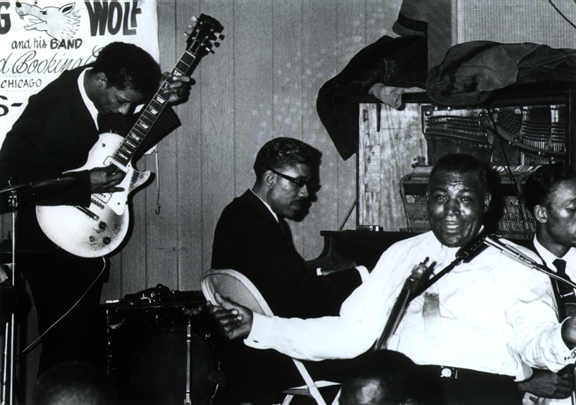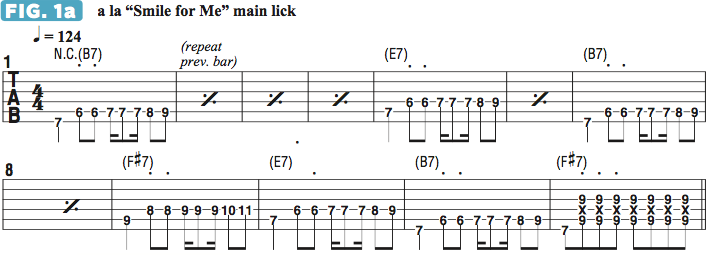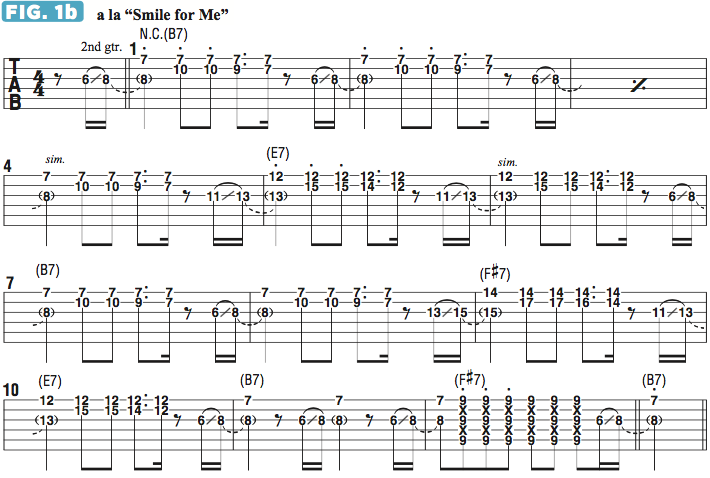In Deep: Howlin' Wolf and Hubert Sumlin
Learn some of the tricks and stylings of Howlin' Wolf and Hubert Sumlin, one of the greatest blues guitar tandems of all time.

On December 4,2011, the blues world lost one of its leading lights and visionary guitarists when Hubert Sumlin, age 80, passed away in Wayne, New Jersey. Hubert was best known for his incredibly influential guitar work while performing and recording with Howlin’ Wolf. He joined forces with the blues giant in Chicago in 1954, when Sumlin was 23 years old, and continued to work with him until Wolf’s death in 1976. Though Sumlin also played briefly with Muddy Waters, he will always be remembered as the rail-like figure playing bursts of signature rhythm guitar and lead lines next to the hulking Wolf, who, in many ways, was like a father to Hubert.
Sumlin was born in Greenwood, Mississippi, and raised in Hughes, Arkansas. He first met Wolf when, as a boy, he snuck into one of Wolf’s shows. In 1953, Wolf asked Sumlin to replace guitarist Willie Johnson in his band. Sumlin’s signature crystal clear tone and adventurous playing style made its mark onHowlin’ Wolf’s first two Chess albums, 1959’s Moanin’ in the Moonlight and 1962’s Howlin’ Wolf.
Deeply respected by everyone from Jimi Hendrix, Eric Clapton, Stevie Ray Vaughan and Buddy Guy to Mick Jagger and Keith Richards, Sumlin had an influence on music that is guaranteed for years to come. He was listed at Number 43 on Rolling Stone’s 100 Greatest Guitarists of All Time, and Howlin’ Wolf is widely regarded as one of the top five greatest blues albums ever recorded.
The standard musical structure of Chicago electric blues most often features two guitars, one of whom lays down a primary rhythmic, or bass line-like, part, while the other adds melodic fills and signature single-note phrases. Such was the case with Howlin’ Wolf and Sumlin (as well as with other great blues guitar tandems, such as Muddy Waters and Jimmy Rodgers, and John Lee Hooker and Eddie Taylor).
A perfect example of this practice is heard on “Shake for Me,”a standard 12-bar blues in B that features distinctive dual-guitar parts. FIGURE 1a illustrates a line similar to Wolf’s ascending bass line–like figure: over B, the riff starts on the one and then climbs chromati- cally from the major third, D#, to the fifth, F#. This line is then transposed to both the four chord, E, and the five chord, F#. Slight palm muting (P.M.) while playing this riff will add both a percussive quality and rhythmic drive.

Over this figure, Sumlin adds melodic two-note lines, played on the top three strings, making direct reference to each chord as the riffs progress, along the lines of FIGURE 1b. Each of these two-note forms is based on a slight permutation of the major triads in the one-four-five progression. Use a clean tone and sharp attack to emulate Sumlin’s signature sound.

The beauty of the blues is that each and every classic song has a specific, signature guitar riff that sets it apart and gives it its unique character. A great example is Howlin’ Wolf’s “The Red Rooster” (also known as “Little Red Rooster”), a song covered by everyone from the Rolling Stones to Sam Cooke to the Grateful Dead. Wolf supplied the main slide guitar lick in this song, performed in open A tuning (low to high, E A E A C# E). FIGURE 2 offers a similar guitar part, played in open A and featuring single-note melodies in conjunction with small chord voicings and vocal-like slide licks.

Though relatively less common, blues songs played in minor keys hold a special place in the history of the music. Prime examples are Muddy Waters’ “That Same Thing,” Otis Rush’s “So Many Roads” and Howlin’ Wolf’s “Who’s Been Talkin’?” FIGURE 3 represents a part similar to the signature line Sumlin adds to the Wolf classic: based on E minor pentatonic (EGABD), the riff creates a hypnotic quality by remaining virtually the same through all three chords of the one-four-five progression. This guitar lick is intended to fall in the spaces between the vocal phrases, which is a musical technique commonly referred to as “call and response.” Notice the use of index-and-middle-finger two-note barres throughout.

Howlin’ Wolf’s music often sits on a single chord as opposed to working through a standard one-four-five progression. This technique, heard on seminal tracks such as “Smokestack Lightnin’,”“Spoonful,”“Wang Dang Doodle,” “Do the Do” and others, is sometimes referred to as “stomp” blues, building power and tension through hypnotic repetition. FIGURE 4 offers a riff along the lines of that heard on “Smokestack Lightnin’ ”: played fingerstyle, the open low E pedal is struck throughout while a melody is performed on the higher strings. Alter your fingerpicking attack throughout to attain a more expressive performance.

FIGURE 5 illustrates a riff along the lines of what’s heard on “Spoonful”: again using a fingerstyle approach and employing the open low E pedal, a descending melody is outlined on the higher strings, giving way to a repeated two-note line that mimics the vocal figure.

Another Wolf classic is “Forty Four,” origi- nally composed and performed by Roosevelt Sykes and featured on Wolf’s very first release. The song has since been covered by such blues and rock greats as Johnny Winter, Eric Clapton Little Feat, Derek Trucks, Eric Burdon and the Black Crowes. FIGURE 6 offers a line similar to that heard in the Wolf version, performed in the key of F and featuring signature melodic lines on the top two strings along with bass-like walking figures that connect each chord in the progression.

Get The Pick Newsletter
All the latest guitar news, interviews, lessons, reviews, deals and more, direct to your inbox!
Guitar World Associate Editor Andy Aledort is recognized worldwide for his vast contributions to guitar instruction, via his many best-selling instructional DVDs, transcription books and online lessons. Andy is a regular contributor to Guitar World and Truefire, and has toured with Dickey Betts of the Allman Brothers, as well as participating in several Jimi Hendrix Tribute Tours.
“There are so many sounds to be discovered when you get away from using a pick”: Jared James Nichols shows you how to add “snap, crackle and pop” to your playing with banjo rolls and string snaps
Don't let chord inversions bamboozle you. It's simply the case of shuffling the notes around








![Joe Bonamassa [left] wears a deep blue suit and polka-dotted shirt and plays his green refin Strat; the late Irish blues legend Rory Gallagher [right] screams and inflicts some punishment on his heavily worn number one Stratocaster.](https://cdn.mos.cms.futurecdn.net/cw28h7UBcTVfTLs7p7eiLe.jpg)


